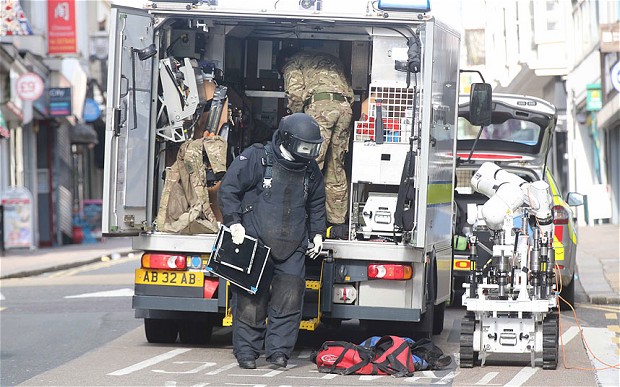Un’ondata di plichi esplosivi inviati agli uffici di reclutamento delle forze armate inglesi potrebbe essere un tentativo di farsi pubblicità piuttosto che una nuova campagna di attacchi esplosivi
La New IRA (Nuova IRA) è il gruppo armato indiziato per l’invio di sette plichi esplosivi agli uffici di reclutamento dell’esercito britannico, viene detto da fonti della sicurezza.
Il gruppo repubblicano si è costituito due anni fa dai resti della Real IRA e di altre fazioni paramilitari.
I centri di reclutamento restano in allarme, ma aperti come di consueto, dopo l’ondata di invii di plichi in grado di esplodere agli indirizzi del sud-est dell’Inghilterra.
Fonti anti-terrorismo hanno detto che tutti i timbri decifrabili sulle buste formato A4 potrebbero essere ricondotte alla Repubblica d’ Irlanda, con almeno due plichi inviati da Dublino e uno inviato da una contea di confine.
Le fonti hanno rivelato altri dettagli sulle bombe, composte da pacchetti di polvere nera esplosiva collegati a detonatori, destinate ad esplodere all’apertura.
Nessuno degli ordigni è esploso. Comunque, proseguono le fonti, l’esplosione avrebbe causato solo lievi ustioni alla vittima.
Per Downing Street gli ordigni “portavano i segni distintivi del terrorismo legato all’Irlanda del Nord”.
Nessun gruppo armato ha ancora rivendicato l’invio dei pacchi bomba ma, secondo le fonti di sicurezza, quella che porta al gruppo della New IRA sarebbe “la principale linea di indagine”.
Gli ordigni sono da ritenersi molto simili a quelli inviati l’anno scorso al comandante della polizia nordirlandese, Matt Baggott, e al Segretario di Stato, Theresa Villiers.
La New IRA si è formata solo nell’estate del 2012, ma ora è la più grande delle fazioni armate repubblicane. È nata dalla fusione della Real IRA – formazione legata alla bomba di Omagh del 1998 – con il gruppo Republican Action Against Drugs di Derry e unità repubblicane “indipendenti” con base in East Tyrone.
Lo zoccolo duro del nuovo gruppo armato è costituito da ex paramilitari dei Provisional IRA. Tuttavie le fonti di sicurezza britanniche riferiscono che gli ordigni spediti per posta erano amatoriali e non sofisticati, se paragonati agli ordigni usati in simili campagne armate negli anni Settanta e Ottanta. Forse l’azione è intesa come trovata pubblicitaria piuttosto che come il tentativo di uccidere o ferire delle persone.
I gruppi armati repubblicani sono stati ampiamente indeboliti da informatori e arresti, minando la loro capacità di compiere attacchi mortali.
Le bombe hanno suscitato condanne trasversali in Irlanda del Nord. Il vice primo ministro Martin McGuinness, dello Sinn Féin, le ha definite “un attacco al processo di pace”, aggiungendo che “i responsabili appartengono al passato. I loro futili atti devono essere condannati”.
I pacchi bomba sono stati recapitati martedì scorso negli uffici di reclutamento di Reading e Chatham. Poi mercoledì una lettera esplosiva è stata consegnata ad Aldershot mentre altri pacchi sono giunti a Brighton, Slough, Canterbury e Oxford nel corso di venerdì.
Tratto da The Telegraph
‘New IRA’ main suspects behind letter bombs
A wave of crude letter bombs sent to Armed Forces recruiting offices is likely to be a publicity stunt by dissident republicans rather than a significant new bombing campaign
A newly-formed dissident republican group called the ‘New IRA’ is the main suspect in the hunt for letter bombers targeting British military recruitment offices, security sources said.
The group formed two years ago from remnants of the Real IRA and other paramilitary factions is most likely behind seven crude parcel bombs delivered to careers offices this week.
Recruiting centres remain on high alert, but open as usual, after the wave of basic, but viable bombs was sent to addresses across the south east of England.
Anti terrorism sources said all the decipherable postmarks on the A4 packages could be traced back to the Republic of Ireland, with at least two sent from Dublin and one sent from a border county.
Sources also revealed more details of the bombs, which were made from basic packets of black explosive powder rigged to crude detonators designed to explode when the parcel was opened.
None of the devices detonated, and sources said they would have caused little more than minor burns to the victim.
Downing Street has confirmed the devices “bore the hallmarks of Northern Ireland-related terrorism”.
No group has yet claimed responsibility for the bombs, but security sources said the dissident republican ‘New IRA’ was the “strongest line of enquiry”.
The devices are believed to be very similar to two sent late last year to Chief Constable Matt Baggott, head of the Northern Ireland police, and the Secretary of State, Theresa Villiers.
The New IRA was only formed in the summer of 2012, but is now the biggest of the violent republican factions. It was formed as an amalgamation of the Real IRA, linked to the 1998 Omagh bombing, a paramilitary vigilante gang called Republican Action Against Drugs in Londonderry and ‘independent’ armed republican units in east Tyrone.
It is based around a hard core of experienced former Provisional IRA paramilitaries. However sources said the week’s wave of bombs was amateurish and unsophisticated compared with similar campaigns of the 1970s and 1980s, suggesting it was a publicity stunt rather than a significant bombing campaign to kill or maim. Paramilitary groups have also been weakened by informants and arrests, undermining their ability to wage deadly attacks.
The bombs sparked cross-party condemnation in Northern Ireland. Martin McGuinness, deputy first minister, called it “an attack on the peace process”, adding “those responsible belong in the past. Their futile acts must be condemned.”
Bombs first arrived at recruiting offices in Reading and Chatham on Tuesday. They were followed by another to Aldershot on Wednesday and then parcels to Brighton, Slough, Canterbury and Oxford on Friday.
No further bombs were received yesterday, but there was a false alarm at one office.
